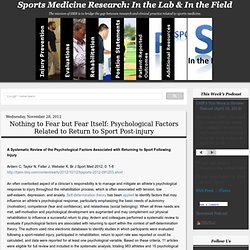

Self-determination theory. In the 1970s, research on SDT evolved from studies comparing the intrinsic and extrinsic motives, and from growing understanding of the dominant role intrinsic motivation played in an individual’s behavior[2] but it was not until mid-1980s that SDT was formally introduced and accepted as a sound empirical theory.

Research applying SDT to different areas in social psychology has increased considerably since the 2000s. Key studies that led to emergence of SDT included research on intrinsic motivation.[3] Intrinsic motivation refers to initiating an activity for its own sake because it is interesting and satisfying in itself, as opposed to doing an activity to obtain an external goal (extrinsic motivation). Different types of motivations have been described based on the degree they have been internalized.
Sports Medicine Research: In the Lab & In the Field: Nothing to Fear but Fear Itself: Psychological Factors Related to Return to Sport Post-injury (Sports Med Res) A Systematic Review of the Psychological Factors Associated with Returning to Sport Following Injury Ardern C, Taylor N, Feller J, Webster K.

Br J Sport Med 2012; 0: 1-8 An often overlooked aspect of a clinician’s responsibility is to manage and mitigate an athlete’s psychological response to injury throughout the rehabilitation process, which is often associated with tension, low self-esteem, depression, and anxiety. Self-determination theory has been applied to identify factors that may influence an athlete’s psychological response, particularly emphasizing the basic needs of autonomy (motivation), competence (fear and confidence), and relatedness (social belonging).
Anterior cruciate ligament- specialized post-operative return-to-sports (ACL-SPORTS) training: a randomized control trial. Muscle strength and hop ... [Knee Surg Sports Traumatol Arthrosc. 2011. Orthopedic Manual Physical Therapy. Biomechanical and neuromuscular factors receive considerable attention in discussing Return to Sport Following ACL Reconstruction.

Psychological considerations, however, despite playing an integral role in returning an injured athlete to their respective sport, often go underappreciated. The purpose of this piece is therefore to briefly review the literature related to the psychology of ACL injury and surgery, and to discuss how the rehabilitation professional can enhance their understanding of the psychological domain to foster improved outcomes in working with this population of athletes. Once a patient has successfully met all return to sport criteria, the next step naturally involves returning to sport. While some patients seamlessly return to their pre-injury status, others struggle with simply returning to their sport.
According to a recent systematic review conducted by Te Wierike et al.